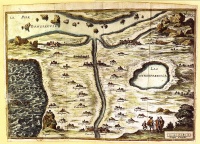Fictional location
From The Art and Popular Culture Encyclopedia
| Revision as of 09:37, 10 December 2015 Jahsonic (Talk | contribs) ← Previous diff |
Revision as of 06:44, 14 March 2024 Jahsonic (Talk | contribs) Next diff → |
||
| Line 1: | Line 1: | ||
| - | [[Image:Carte du tendre.jpg|thumb|right|200px|The ''[[Map of Tendre]]'' (''Carte du Tendre'') is a French map of an [[imaginary country]] called ''[[Tendre]]''. It shows a geography entirely based around the theme of [[love]]]] | + | [[Image:Carte du tendre.jpg|thumb|right|200px|The ''[[Map of Tendre]]'']] |
| {{Template}} | {{Template}} | ||
| - | :''[[list of fictional locations]]'' | ||
| '''Fictional locations''' are places that exist only in [[fiction]] and not in reality. Writers may create and describe such places to serve as backdrop for their fictional works. Fictional locations are also created for use as settings in [[Role-playing games]] like [[Dungeons and Dragons]]. They may also be used for technical reasons in actual reality for use in the development of specifications, such as the fictional country of ''[[Bookland (imaginary place)|Bookland]]''. | '''Fictional locations''' are places that exist only in [[fiction]] and not in reality. Writers may create and describe such places to serve as backdrop for their fictional works. Fictional locations are also created for use as settings in [[Role-playing games]] like [[Dungeons and Dragons]]. They may also be used for technical reasons in actual reality for use in the development of specifications, such as the fictional country of ''[[Bookland (imaginary place)|Bookland]]''. | ||
Revision as of 06:44, 14 March 2024

|
Related e |
|
Featured: |
Fictional locations are places that exist only in fiction and not in reality. Writers may create and describe such places to serve as backdrop for their fictional works. Fictional locations are also created for use as settings in Role-playing games like Dungeons and Dragons. They may also be used for technical reasons in actual reality for use in the development of specifications, such as the fictional country of Bookland.
Fictional locations vary greatly in their size. Very small places like a single room are kept out of the umbrella of fictional locations by convention, as are most single buildings. A fictional location can be the size of a university (Howard Phillips Lovecraft's Miskatonic University), a town (Stephen King's Salem's Lot), a county (Raintree County), a state (Winnemac in various Sinclair Lewis stories), a large section of continent (as in Lord of the Rings, which supposedly represents Europe before 'western' sections sank), a whole planet (Anne McCaffrey's Pern), a whole galaxy (Isaac Asimov's Foundation books), even a multiverse (His Dark Materials). In a larger scale, occasionally the term alternate reality is used, but only if it is considered a variant of Earth rather than an original world. Austin Tappan Wright's Islandia has an invented continent, Karain, on our world.
See also
- Cockaigne
- Cloud cuckoo land
- Fictional place of publishing
- Amalgamation (fiction)
- List of fictional locations
- Area code 555
- Fictional universe
- List of mythological places

